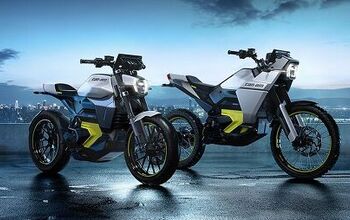2025 Can-Am Origin and Pulse Electric Motorcycles – First Look

Origin ADV starts at $14,499 while naked Pulse begins at $13,999
Can-Am has made its anticipated return to two-wheelers with the launch of the new electric Origin adventure bike and Pulse roadster. Both models are available now for pre-order, with deliveries scheduled for early 2025. Pricing starts at $13,999 for the Pulse and $14,499 for the Origin, with an special ’73 trim package for each model available for an additional $2,000. The two electric motorcycles join Can-Am’s three-wheelers in further expanding the on-road lineup of parent company Bombardier Recreational Products.
“Today, we are reclaiming our two-wheel heritage by bringing new excitement to the electric motorcycle industry,” said José Boisjoli, President and CEO of BRP. “50 years ago, Can-Am celebrated many victories with its Track ’n Trail motorcycles, and we are bringing that pedigree back with a focus on modern electric power, connectivity and thrill. We intend to become a global leader in that space with true innovation designed to simplify the riding experience for new riders and introduce electric motorcycles to all.”
The Pulse and Origin share the same platform built around the proprietary Rotax E-Power power unit, which combines the battery, charger, inverter and motor. The power unit is the main component of the chassis, and is fully liquid-cooled to help maintain consistent performance even in hot or cold weather conditions. Can-Am offers a standard 5-year warranty on the battery.
The Pulse offers four ride modes (Normal, ECO, Rain, and Sport+) while the Origin offers six (Normal, ECO, Rain, Sport, Off-road, and Off-road+). Each offers a different level of throttle response and traction control.
Both models offer a combination of active and passive regeneration. Passive regeneration uses the motorcycle’s momentum when releasing the throttle to restore some charge to the batteries. Active regen can regain even more power by twisting the throttle forward. Both active and passive regen can be adjusted independently to maximum, minimum, or off.
Can-Am claims a peak output of 47 hp (27 hp continuous) and 53 lb-ft. of torque from the motor. Both models claim a top speed of 80 mph. The Pulse claims a 0-60 time of 3.8 seconds, but the Origin, with its heavier weight, larger wheels and dual-sport tires claims a time of 4.3 seconds. Power is delivered to the rear wheel through a sealed chaincase that also serves as the single-sided swingarm. With oil lubrication and an automatic chain tensioner, Can-Am claims the chaincase produces less noise and requires less maintenance.
The integrated lithium-ion battery has a capacity of 8.9 kWh. The Origin claims a range of 90 miles in the city and 71 miles combined with highway riding, while the Pulse squeezes out a bit more, claiming 100 city miles and 80 combined miles.
The on-board 6.6 kW charger is Level 1 and Level 2 compatible, and liquid-cooled so that charging speeds don’t need to slow down due to excessive heat. With Level 2 charging, Can-Am claims it takes 1 hour and 30 minutes to go from 0 to 100%, while a charge from 20 to 80% takes 50 minutes. Via a regular 120V Level 1 charger, Can-Am claims a 0-100% charge time of 5 hours, 15 minutes, and 20-80% time of 3 hours, 10 minutes.
As with most electric motorcycles, the Can-Am models have no clutch and a single gear. A reverse function helps for moving around tight spaces.
The Origin comes equipped with a 43 mm KYB inverted fork and a KYB HPG rear shock with adjustable preload, compression, and rebound, both offering 10 inches of travel. The Pulse uses a 41mm KYB inverted fork, and a Sachs twin-tube coil-over shock with just preload adjustability, and 5.5 inches of front and rear travel.
Braking components for both models are provided by J.Juan, with a single two-piston floating caliper and 320mm disc up front and a single-piston floating caliper and 240mm disc at the back. ABS comes standard.
Dunlop supplies the tires for both models. The Pulse comes with Sportmax GPR-300 tires for its cast wheels, with a 110/70 R17 up front and a 150/60 R17 at the rear. The Origin is equipped with D605 dual-sport tires on its wire-spoke wheels, with a 90/90 R21 up front and a 120/80 R18 at the rear (both tubed).
A 10.25-inch TFT touchscreen display with BRP Connect and Apple CarPlay manages the vehicle vitals and infotainment system including media and onscreen navigation. The infotainment system can be paired with a mobile app and can receive over-the-air updates.
Both models come with a number of LinQ Nano mounting points offering toolless attachment of a number of accessories including luggage and windscreens. For North America, the Origin and Pulse come standard with a single seat, with the pillion seat optional. In Europe, the passenger seat comes standard. Can-Am claims a curb weight of 412 pounds for the Origin and 390 pounds for the Pulse.
The Origin comes in Bright White for $14,499, or Carbon Black for an extra $500. For a higher price point, the $16,499 Origin ‘73 trim comes with a Sterling Silver Satin color scheme along with a windshield, LED signature position lighting and a bike cover. The Pulse is also available in Bright White for $13,999 or Carbon Black for an additional $500. The Pulse ‘73 trim is priced at $15,999, coming with a Sterling Silver Satin color with Acid Yellow highlights on the wheels, along with a flyscreen, signature LED lights and vehicle cover.
Specifications | Can-Am Origin | Can-Am Pulse |
|---|---|---|
Motor Type | ROTAX E-POWER, liquid-cooled | |
Power | 47 hp peak / 27 hp continuous (claimed) | |
Torque | Motor Peak: 53 lb-ft. from 0 to 4600 rpm (claimed) | |
Top Speed | 80 mph / 129 kph (claimed) | |
0-60 mph Acceleration | 4.3 seconds (claimed) | 3.8 seconds (claimed) |
Battery Type | Integrated, lithium-ion | |
Battery Capacity | 8.9 kWh | |
Cooling System | Liquid-cooled: battery, inverter and on-board charger | |
Estimated Range | City: 90 miles (145 km) Combined (WMTC): 71 miles (115 km) Sustained 50 mph (80 kph): 52 miles (84 km) | City: 100 miles (165 km) Combined (WMTC): 80 miles (130 km) Sustained 50 mph (80 kph): 55 miles (89 km) |
Function | Active Regen, Passive Regen | |
Charger | On-board charger: 6.6 kW (Level 1 & Level 2 compatible) | |
Connector | Type 1 J1772 | |
Level 2 Charging Time (240 V) | 50 min. (20-80%) 1 hour 30 min. (0-100%) | |
Level 1 Charging Time (120 V) | 3 hours 10 min. (20-80%) 5 hours 15 min. (0-100%) | |
Transmission | Clutchless direct drive | |
Final Drive | Chaincase with silent chain | |
Function | Reverse function | |
Swingarm | Single-sided swingarm | |
Rake / Trail | 30° / 4.6 inches | 27.2° / 4.0 inches |
Front Suspension | KYB 43 mm inverted fork; 10 inches of travel | KYB 41 mm inverted fork; 5.5 inches of travel |
Rear Suspension | KYB HPG shock with adjustable preload, compression rebound; 10 inches of travel | SACHS twin-tube coil-over shock with preload adjustment; 5.5 inches of travel |
Front Brake | J.Juan 2-piston floating caliper, 320 mm disc; ABS | |
Rear Brake | J.Juan 1-piston floating caliper, 240 mm disc; ABS | |
Front Tire | Dunlop D605 90/90 R21 (with tube) | Dunlop Sportmax GPR-300 110/70 R17 |
Rear Tire | Dunlop D605 120/80 R18 (with tube) | Dunlop Sportmax GPR-300 150/60 R17 |
Front Wheel | Spoked wheel, Carbon black 21 x 1.85 in. | Cast wheel 17 x 3.5 in. |
Rear Wheel | Spoked wheel, Carbon black 18 x 2.5 in. | Cast wheel 17 x 4.5 in. |
Colors | Standard: Bright White or Carbon Black ’73: Sterling Silver Satin | Standard: Bright White or Carbon Black ’73: Sterling Silver Satin with Carbon Black /Acid Yellow wheels |
Length | 86.8 inches | 79.9 inches |
Width | 33.9 inches | 37.3 inches |
Height | 55.7 inches | 46.1 inches |
Wheelbase | 59 inches | 55.6 inches |
Seat Height | 34 inches | 30.9 inches |
Ground Clearance | 10.8 inches | 5.7 inches |
Curb Weight | 412 lb (claimed) | 390 lb (claimed) |
Maximum Vehicle Load | 745 lb (claimed) | 723 lb (claimed) |
Display | 10.25 in. touchscreen display with BRP Connect | |
Navigation System | Apple CarPlay | |
Drive Modes | Normal, ECO, Rain, Sport, Off-Road, Off-Road+ | Normal, ECO, Rain, Sport+ |
Switchgear | Backlit handlebar control module | |
Traction Control | Motorcycle Traction Control | |
Vehicle Warranty | 2 years | |
Battery Warranty | 5 years / 31,068 miles | |
Extended Service | Available from 12 to 36 months for vehicle excluding battery | |
Standard Features | LED headlight Glove box with USB port LinQ anchor points Skid plate LinQ Windshield (’73) Signature LED lights (’73) Vehicle cover (’73) | LED headlight Glove box with USB port LinQ anchor points Skid plate LinQ gauge spoiler (’73) Signature LED lights (’73) Vehicle cover (’73) |
2025 Can-Am Pulse and Origin Gallery
Become a Motorcycle.com insider. Get the latest motorcycle news first by subscribing to our newsletter here.

Dennis has been a part of the Motorcycle.com team since 2008, and through his tenure, has developed a firm grasp of industry trends, and a solid sense of what's to come. A bloodhound when it comes to tracking information on new motorcycles, if there's a new model on the horizon, you'll probably hear about it from him first.
More by Dennis Chung




































Comments
Join the conversation
🙅♂️Not with that range, with that power at that price 🙅♂️
It looks fine, but those specs need major improvements..
Unlike most of the other commenters I like the Pulse version of this bike. It hits a GoldiLocks spot between the most expensive electric bicycles and full-on electric motorcycles like Zero, Energica, or LiveWire. Sure, it's pricier than its mission profile would normally support, but it's far faster than electric bicycles and more than fast enough for the urban work most electric motorcycles are best at, and the limited range is not an issue for strictly urban travel. Based on the current practice of adding dealer markups to the LiveWire S2 line of nearly $2K, this bike is roughly 3K under the S2 pricing, so the savings may be a good trade for some horsepower and top speed you can't really use in the urban setting.